A Private Tour today, the second day of a five day programme put together for a US client, a mixture of private and scheduled group days. Again, we went to places and to look for some birds we would not necessarily be seeing on the other days.
We started at Holkham Hall, with a quick walk round the woods. It can often be quiet at this time of the year, but we hoped to pick up some woodland birds. We could hear a Nuthatch calling as soon as we went in through the gate and found it piping in the top of a fir tree. There were several Treecreepers calling as well, and lots of tits in the trees. But we couldn’t find any woodpeckers today.
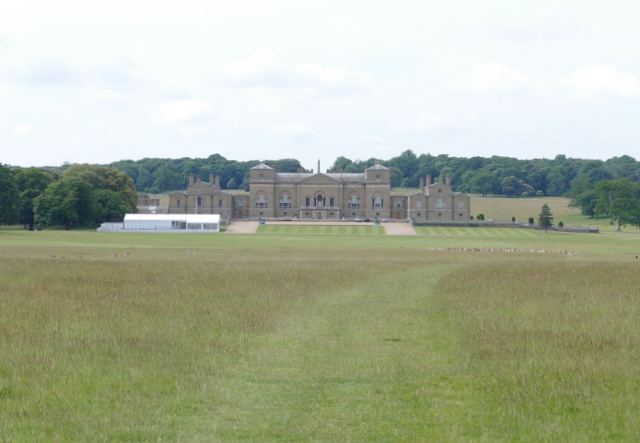 Holkham Hall – the view from the monument
Holkham Hall – the view from the monument
Looking down towards the Hall, we could see lots of birds down on the cut lawns in front. The largest amongst them were three Barnacle Geese, part of the growing number of feral birds in the area, and later we found at least ten more further round. The bulk of the throng was made up of Black-headed Gulls and a quick scan through quickly located a couple of adult Mediterranean Gulls with them, their darker and more extensive black hoods standing out even at a distance. There were also lots of Fallow Deer out in the longer grass, with several small fawns running around with them.
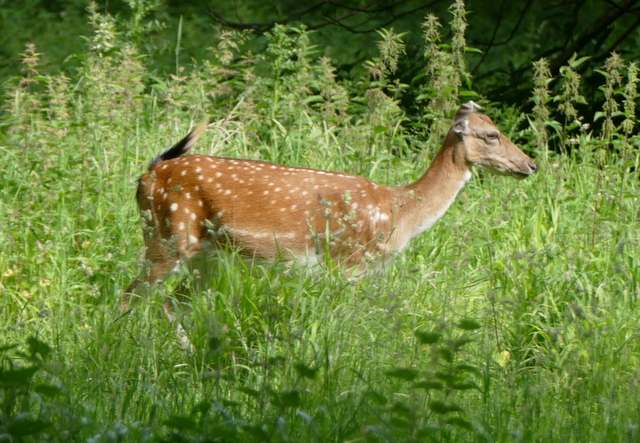 Fallow Deer – there is a big herd in the park at Holkham Hall
Fallow Deer – there is a big herd in the park at Holkham Hall
We didn’t want to waste too much time in the park today, so we moved swiftly on towards Burnham Overy, where we parked and set off along the track out across the grazing marshes to the seawall. A Common Whitethroat perched nicely on the top of the hedge singing. Nearby, two smaller and duller greyish brown warblers flew across the path and we got a look at them as they landed and hopped around for a second on the outside of the bush, Lesser Whitethroats. They have stopped singing at the moment and quickly disappeared into the hedge, which is where they prefer to be. Unlike their close relatives, they don’t tend to sit up on the tops. It was good to be able to compare the two species, one after the other.
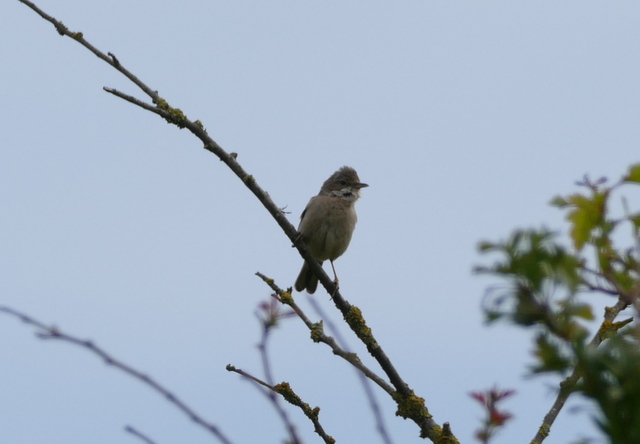 Common Whitethroat – perched up singing on the top of a bush
Common Whitethroat – perched up singing on the top of a bush
The Sedge Warblers along the path which sat up on the tops of the bushes earlier in the spring are a little more secretive now. We heard several and saw them darting into cover, but the need to sing non-stop has now diminished and they are busier finding food for their nestlings now.
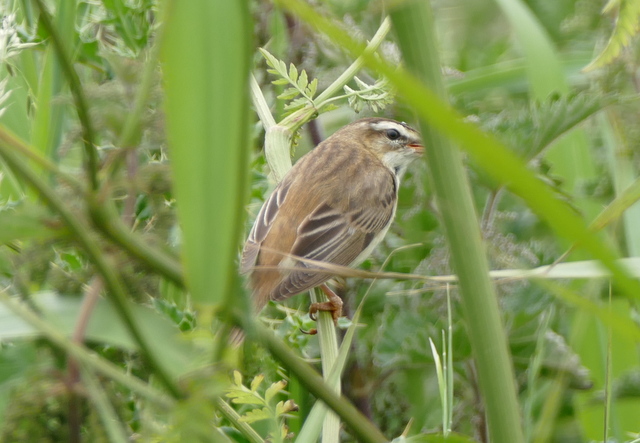 Sedge Warbler – they are more secretive now than in the spring
Sedge Warbler – they are more secretive now than in the spring
We did have a nice Reed Warbler which came up to the top of the reeds in the ditch by the path to sing. Usually it is the other way round, with the Reed Warblers harder to see than the Sedge!
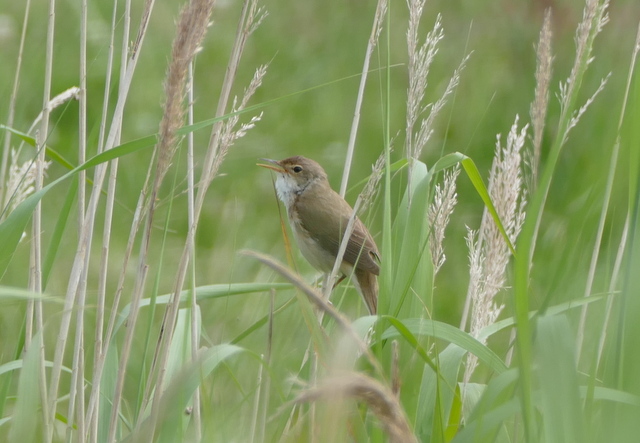 Reed Warbler – this one came up out of the reeds to sing for us
Reed Warbler – this one came up out of the reeds to sing for us
As we got up onto the seawall, we could see that the reedbed pool was empty save for a Coot and a couple of moulting Mallards. We stood for a while scanning either side of the path and could hear more Reed and Sedge Warblers, plus a couple of Reed Buntings which perched more helpfully in the tops of the bushes. We could also hear the ‘pinging’ of Bearded Tits and we saw a couple of birds whizz across the top of the reeds before dropping back into cover. While we were standing there, a smart male Marsh Harrier appeared over the reedbed and circled low and close to us. It started to drift away, but then turned and flew right along the seawall towards us, veering away over the saltmarsh at the last minute.
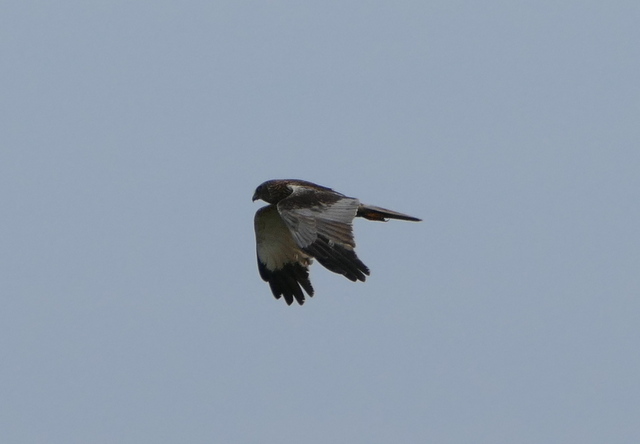 Marsh Harrier – this male flew past us on the seawall
Marsh Harrier – this male flew past us on the seawall
Out on the saltmarsh, we could see a few waders. A group of about 10 Black-tailed Godwits were mostly asleep. There were also a few Redshank and Oystercatcher on the mud. As we walked further along, we saw a big flock of large waders circle up out over the harbour – about 30 Curlew. Another sign that autumn is on its way!
The rest of the walk, to the end of the boardwalk and out across the dunes to Gun Hill, was fairly quiet save for the constant singing of Skylarks and Meadow Pipits and the odd pair of Linnets which flew up from the bushes. The surprise was two Siskins which flew overhead calling – presumably on their way somewhere. As we got out to Gun Hill we flushed a Cuckoo from the bushes, dropping quickly out of sight over the dunes. We climbed up to the top and the Cuckoo appeared again from the Sea Buckthorn and flew round in front of us before disappearing back the way we had just come. Presumably in search of an unsuspecting pair of Meadow Pipits!
Out at the point, there was no sign today of any Spoonbills in the harbour, but there were several Oystercatchers and a Ringed Plover. As we walked round on the beach, we found several more Ringed Plovers along the shoreline.
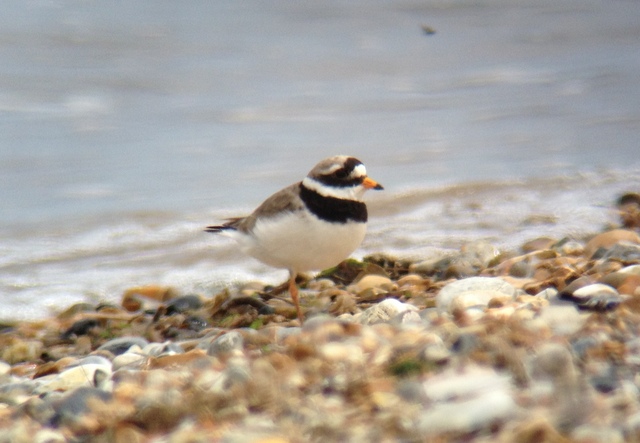 Ringed Plover – we found several along the beach at Gun Hill
Ringed Plover – we found several along the beach at Gun Hill
There was a big group of Little Terns roosting out on a shingle spit in the harbour, but at first we could see little in the way of activity in the colony on the beach. They seem a little subdued at the moment, for some reason. As we walked along the shoreline, we could see a single Common Tern on the nest first, but eventually we found a few Little Terns sitting. We got a good look at them from a discrete distance through the scope, where we didn’t disturb them.
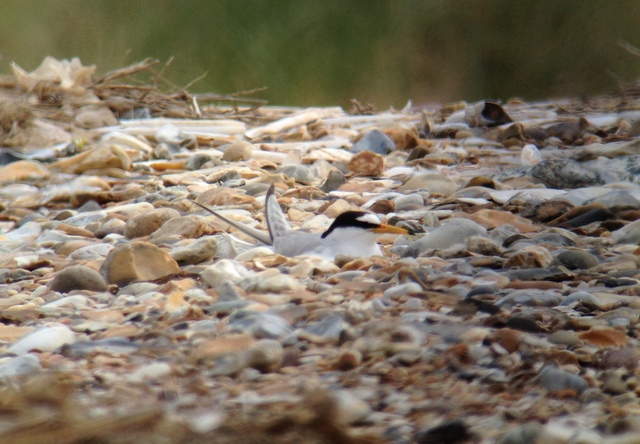 Little Tern – a few were sitting on the beach at Gun Hill
Little Tern – a few were sitting on the beach at Gun Hill
The walk back was fairly uneventful at first. However, as we got back to the reedbed pool, we could see a large white shape on the edge of the reeds. We just got a quick look at it before it disappeared out of view – a Spoonbill. Finally! We waited a minute or so and eventually it walked back out, sweeping its bill from side to side through the water, occasionally lifting its head quickly to snap up something it had found.
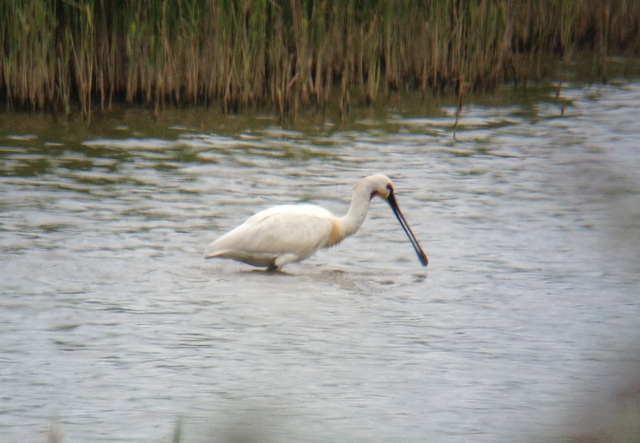 Spoonbill – an adult feeding on the reedbed pool by the seawall
Spoonbill – an adult feeding on the reedbed pool by the seawall
We watched it for a bit and then suddenly two more Spoonbills dropped in as well. Just like buses! One was an adult, but the other was slightly smaller, much whiter and with a short teaspoon-bill – a juvenile, possibly on one of its first forays away from the colony. We watched the two adult Spoonbills walk off feeding and at first the juvenile stood on its own looking a bit lost. Then it started to try to feed as well, though its sweeping action was much slower and a lot less practiced. We didn’t see it catch anything, but it was trying its best!
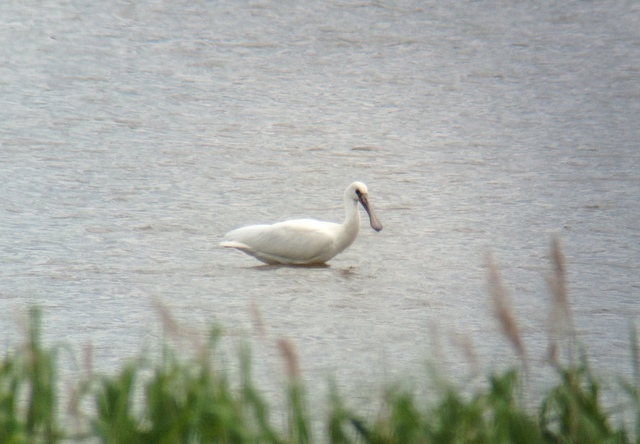 Spoonbill – a fresh juvenile with a rather short ‘teaspoon-bill’
Spoonbill – a fresh juvenile with a rather short ‘teaspoon-bill’
As we were walking back to the car, a bright orange butterfly flew past us over the brambles by the path. It dropped down to land briefly on the track and confirmed our initial suspicions – it was a Dark Green Fritillary, the first we have seen this year. Unfortunately it didn’t linger, and powered off along the path ahead of us. That was not the only butterfly interest of the morning – we had also seen quite a few Meadow Browns and a couple of Painted Ladys on our walk.
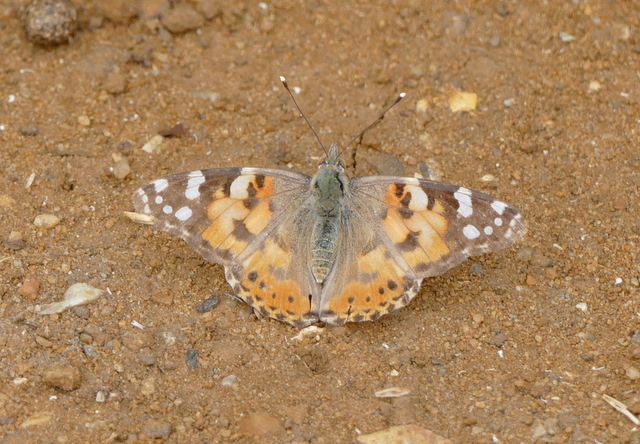 Painted Lady – we saw a couple today out in the dunes
Painted Lady – we saw a couple today out in the dunes
We had also seen a few caterpillars. A couple of hairy Garden Tiger moth caterpillars crawled over the path. And out in the dunes, the small scattered plants of Ragwort were absolutely covered in yellow and black Cinnabar moth caterpillars.
 Cinnabar Moth caterpillar – the Ragwort was covered with them today
Cinnabar Moth caterpillar – the Ragwort was covered with them today
After lunch at Holkham by Lady Anne’s Drive, enlivened by a Hedgehog strolling past the picnic tables and into the long grass, we walked west along the inner edge of the pines. As we set off, we could hear Blackcap and Chiffchaff singing and several tits calling. However, much of the walk out was quiet today, in the heat of the early afternoon. There were several Jays around today, and one perched up nicely for the cameras.
 Jay – we saw several on the edge of the pines today
Jay – we saw several on the edge of the pines today
As soon as we got into Joe Jordan hide, we could see the Spoonbills. A large group were doing what Spoonbills like to do most – sleeping. We could see at least eleven birds, a mixture of adults and juveniles.
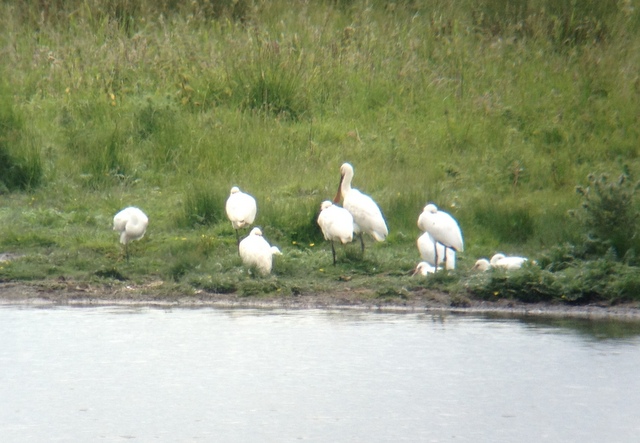 Spoonbills – at least 11 adults & juveniles, mostly asleep
Spoonbills – at least 11 adults & juveniles, mostly asleep
Then two more adult Spoonbills appeared from out of sight behind the reeds, feeding in the shallow water. Pretty soon, they were joined by two more out of the group, and we watched four adults feeding in unison around the pool. Odd birds were also coming and going. One adult Spoonbill, possibly newly arrived from a feeding foray, was pursued around the pool by its juvenile, the latter bobbing its head and flapping its wings, asking to be fed. It wouldn’t give up – we saw the two of the several minutes later, the adult still being pursued.
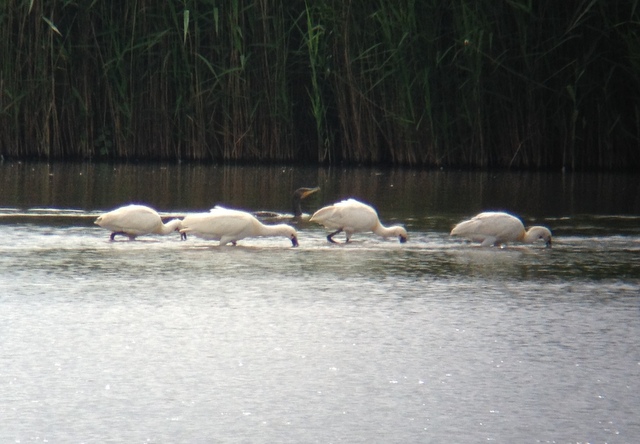 Spoonbill – several adults were feeding in the shallow water
Spoonbill – several adults were feeding in the shallow water
There were plenty of other things to see from the hide as well. A female Marsh Harrier flew in carrying prey and we watched her drop down into the reeds, presumably to feed a hungry brood. A couple of minutes later, she was off out again but it wasn’t long before she returned laden-taloned once again. There was no sign of the male bringing her anything. A Red Kite circled lazily in the sky beyond the trees. And a Common Buzzard flew across towards us over the grazing marshes, before attracting the attentions of a Marsh Harrier, which proceeded to circle rapidly higher above it before dive-bombing it.
The usual flocks of feral Greylag Geese and the odd pair of Egyptian Geese were out on the grass. However, a closer scan revealed a few Pink-footed Geese in amongst them. Most of the wintering birds left already in February, but a very small number remain right through the summer, possibly sick or injured birds. The other main highlight was a pair of Grey Partridge out on the grass in front of the hide.
We walked out into the dunes and had a quick look at the sea. A distant flock of Common Scoter were being harassed by some gulls. The dunes themselves were quiet bird-wise, but we did see several more Dark Green Fritillaries fluttering around among the bushes. Unfortunately none really stopped still long enough to perform for the cameras. Speaking to one of the wardens, it would seem the first ones of the year here were only seen yesterday.
 Dark Green Fritillary – there were several out in the dunes today
Dark Green Fritillary – there were several out in the dunes today
We still had time for one last stop, so we headed to the local gull colony. We could hear lots of Black-headed Gulls squawking as we walked up. This afternoon, there were lots of gulls down on the sand below the colony and bathing in the water. A quick scan revealed a good number of Mediterranean Gulls amongst them, the more extensive black hoods and white wing tips giving the adults away from their regular counterparts.
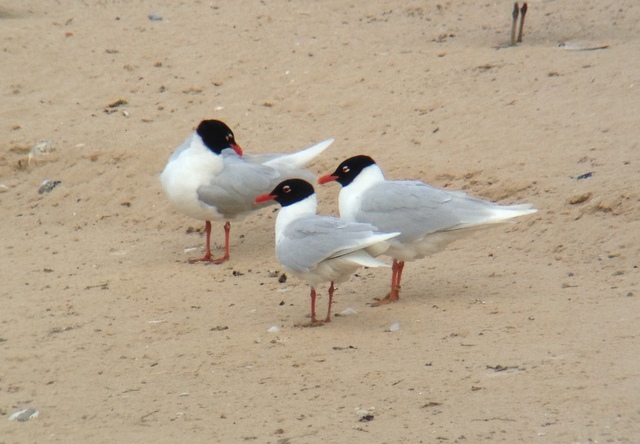 Mediterranean Gulls – at least 9 adults, plus various younger birds today
Mediterranean Gulls – at least 9 adults, plus various younger birds today
There was also a small number of 2nd summer Mediterranean Gulls, and a few 1st summers as well. It was good to get a chance to look at the age-related differences between them. One of the 2nd summers was sporting a colour ring with an alphanumeric code on it. Through the scope we could read the code, so it will be interesting to see if we can find out where it has come from.
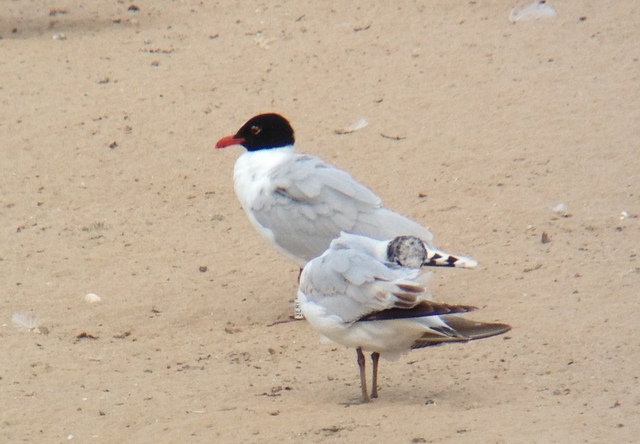 Mediterranean Gulls – 1st sum in front with colour-ringed 2nd sum behind
Mediterranean Gulls – 1st sum in front with colour-ringed 2nd sum behind
There were fewer terns than in recent weeks. Whether the nests have failed or been disturbed was not clear, but most of the Common Terns seem to have deserted the nest sites. Looking carefully, we eventually found a couple of Arctic Terns as well, out on the mud beyond. We watched them hunting, hovering over the small pools out on the saltmarsh. It is a real treat to watch these here, as there are not many pairs in Norfolk, given our position right at the southern edge of their breeding range.
After that, we headed for home. We were just leaving Wells when a Hobby buzzed through a flock of swallows and martins over the field by the road. A great sight and a suitable way to end the day.
















